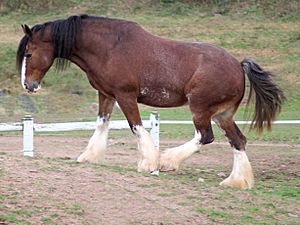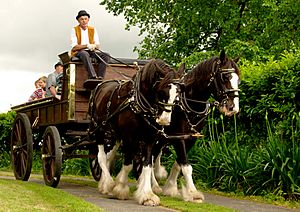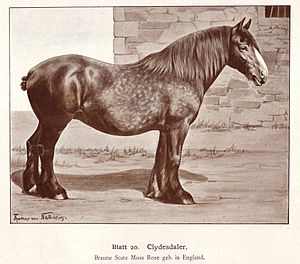Clydesdale horse facts for kids
 |
|
| Conservation status |
|
|---|---|
| Country of origin | Scotland |
| Standard |
|
| Traits | |
| Weight |
|
| Height |
|
| Colour |
|
The Clydesdale is a special type of horse from Scotland. It is known as a draught horse, which means it's a strong horse used for pulling heavy things. This breed gets its name from the Clydesdale area in Scotland, which is the valley of the River Clyde.
The story of the Clydesdale began in the 1700s. Strong Flemish stallions (male horses) were brought to Scotland. They were bred with local mares (female horses). Later, some Shire horses were also added to the mix. The name "Clydesdale" was first used for these horses in 1826. Soon, Clydesdales became popular across Scotland and northern England.
In 1877, a special group called the breed society was formed. After this, many thousands of Clydesdales were sent to countries all over the world. Australia and New Zealand were two big destinations. However, in the early 1900s, their numbers started to drop. This happened because many horses were used in the First World War. Also, new machines began to do the work horses used to do on farms. By the 1970s, the breed was almost extinct. Luckily, their numbers have grown a bit since then, but they are still considered a vulnerable breed.
Clydesdales are big and powerful horses. They were traditionally used for pulling heavy loads, like farm equipment or wagons on roads. Today, they are mostly used as carriage horses. You might see them ridden or pulling carriages in parades. Some have even been drum horses for the Household Cavalry in the UK. In the United States, the Anheuser-Busch brewery uses a famous team of eight Clydesdales for publicity.
Contents
History of the Clydesdale
The Clydesdale horse is named after the area called Clydesdale. This area is now known as Lanarkshire and is famous for the River Clyde. In the mid-1700s, large Flemish stallions were brought to Scotland. They were bred with local mares. This created foals (baby horses) that were bigger than the horses already there.
One important mare, born in 1806, was called "Lampits mare." Her family line can be found in almost every Clydesdale alive today. One of her foals, Thompson's Black Horse (also known as Glancer), was very important for the breed.
The name "Clydesdale" was first used for these horses in 1826. This was at a show in Glasgow. Another idea about their origin was that they came from Flemish horses brought to Scotland as early as the 1400s. But most people agree the first story is more likely.
In Scotland, there was a system for hiring out stallions. Records of this go back to 1837. Local farming groups would hold shows to pick the best stallion. The owner would get a prize. In return, the owner had to take the stallion around a certain area to breed with local mares. This system helped spread the Clydesdale type across Scotland and into northern England.
By 1840, Scottish draught horses and Clydesdales were seen as the same breed. In 1877, the Clydesdale Horse Society of Scotland was created. Then, in 1879, the American Clydesdale Association was formed for people in the U.S. and Canada. The first American stud book (a record of horse family trees) was published in 1882.
Many Clydesdales were sent out of Scotland in the late 1800s and early 1900s. For example, 1,617 stallions left in 1911 alone. Between 1884 and 1945, over 20,000 horses were exported. They went to countries in the British Empire, North and South America, Europe, and Russia.
The First World War meant thousands of horses were needed for the war. After the war, the number of Clydesdales went down. This was because farms started using more machines instead of horses. This decline continued between the two World Wars. After the Second World War, the number of breeding stallions in England dropped a lot. By 1975, the Rare Breeds Survival Trust said they were vulnerable to extinction. This meant fewer than 900 breeding females were left in the UK.
Many horses exported from Scotland went to Australia and New Zealand. In 1918, the Commonwealth Clydesdale Horse Society was formed in Australia. Between 1906 and 1936, Clydesdales were so popular in Australia that other draught breeds were hardly known. Over 25,000 Clydesdales were registered in Australia between 1924 and 2008. Because of their importance, the Clydesdale was called "the breed that built Australia."
In the 1990s, the number of Clydesdales started to increase. By 2005, they were moved to "at risk" status in the UK. This meant there were fewer than 1,500 breeding females. By 2010, they were back to "vulnerable." In 2010, the worldwide population was about 5,000 horses. Around 4,000 were in the US and Canada, 800 in the UK, and the rest in other countries like Russia, Japan, Germany, and South Africa.
What Clydesdales Look Like
The way Clydesdales look has changed over time. In the 1920s and 1930s, they were smaller than other large draught horses like the Shire or Percheron. But starting in the 1940s, breeders chose to make them taller. This made them look more impressive in parades and shows.
Today, Clydesdales are usually between 162 to 183 centimeters (about 5.3 to 6 feet) tall. They weigh between 700 to 900 kilograms (about 1,500 to 2,000 pounds). Some male horses can be even bigger, standing over 183 cm tall and weighing up to 1,000 kg (2,200 pounds). They have a straight or slightly curved face, a wide forehead, and a broad nose.
Clydesdales are very muscular and strong. They have a curved neck, high withers (the ridge between the shoulder blades), and sloped shoulders. Horse groups pay close attention to their hooves and legs. They also look at how the horses move. Clydesdales move actively, lifting their hooves clearly. They give an impression of power and quality. They are energetic and have a happy way of moving and looking.
Clydesdales can sometimes get a disease called chronic progressive lymphedema. This causes swelling and skin problems on their lower legs. Another skin issue on their lower legs, where they have a lot of hair, is sometimes called "Clyde's itch." It might be caused by a type of mange. Clydesdales can also get sunburn on any pink skin around their faces.
Most Clydesdales are bay (brown with black points). But they can also be black, grey, or chestnut. Many have white markings, like white on their face, feet, and legs. They might also have some white spots on their lower belly. They have lots of long hair, called feathering, on their lower legs. These white markings are thought to be caused by special genes.
Some Clydesdale breeders want white faces and legs, but no spots on the body. To get this, they often breed a horse with only one white leg to a horse with four white legs and body spots. This usually results in a foal with the desired amount of white markings.
Many buyers prefer bay and black horses, especially those with four white legs and white faces. Sometimes, people even choose horses with small health issues if they have the color and markings they want. Horse groups say that no color is bad. Horses with roaning (white hairs mixed in) and body spots are becoming more accepted.
How Clydesdales Are Used
Clydesdales were first used for farming. They also pulled coal in Lanarkshire and heavy loads in Glasgow. Today, Clydesdales are still used for pulling things. This includes farm work, logging, and pulling carriages. They are also shown in competitions and ridden, and some people keep them just for fun. Clydesdales are popular for carriage services and parades because of their white, feathery feet.
Besides pulling carriages, Clydesdales are also show horses. They compete in classes where they are led or pull a harness. These shows happen at county and state fairs, and at bigger national events.
Some of the most famous Clydesdales are the teams that make up the Budweiser Clydesdales. These horses were first bought by the Budweiser Brewery after Prohibition ended in the United States. They have become a worldwide symbol of both the breed and the brand. The Budweiser breeding program has very strict rules for color and looks. This has made many people in the United States think that Clydesdales are always bay with white markings.
Some Clydesdales are ridden and can be shown under saddle. They are also driven. Because they have a calm nature, they are easy to train. They can make great trail horses. Clydesdales and Shires are used by the British Household Cavalry as drum horses. They lead parades on special occasions. These horses are often eye-catching colors like piebald (black and white), skewbald (brown and white), and roan (mixed white and colored hairs). To be a drum horse, a Clydesdale must be at least 17 hands (about 172 cm) tall. They carry the Musical Ride Officer and two silver drums, each weighing 56 kg (123 pounds).
In the late 1800s, some Clydesdale blood was added to the Irish Draught breed. This was to try and make that breed stronger. However, it wasn't seen as a success. Irish Draught breeders felt the Clydesdale blood made their horses rougher and more likely to have leg problems. The Clydesdale did help create the Gypsy Horse in Great Britain. It also helped develop the Australian Draught Horse. In the early 1900s, Clydesdales were often bred with Dales Ponies. This created medium-sized draught horses useful for pulling wagons and military equipment.
Images for kids
See also
 In Spanish: Caballo Clydesdale para niños
In Spanish: Caballo Clydesdale para niños





